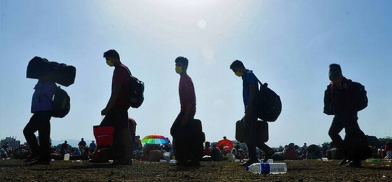Nepali workers heading to India as restrictions ease
Oversees migration for work forms a crucial segment of Nepal’s economy

Oversees migration for work forms a crucial segment of Nepal’s economy. Remittances alone contribute over a quarter of Nepal’s GDP. But necessity, rather than choice, is what drives this migration. In 2020, when the pandemic stuck the world, many returned home, thinking to stay back even for a lesser income in their home country .
Eleven months on, as travel restrictions eases around the world, their stay in homes seems over. Necessity, again, is driving their destination rather than the choice of staying closer to home. For them, there is no work that can give them freedom and the choice to remain in Nepal.
As border points across Nepal and India are opening, many Nepali workers are heading to India for jobs. One such border point, Jamnuha, in Banke district of India’s Bihar state was opened recently. A report in The Himalayan Times says around 500 people are crossing the border point daily.
Most crossing the border are from the western Sundar Paschim province of Nepal. In 2020, during the global lockdown, around 300,000 -400,000 people had returned to the province. But the hope of staying back in their own homes was cut short by precarious economic conditions.
Since August last year, people started going back to their respective work workplace. According to a report in The Kathmandu Post, over 300,000 people from these areas had gone back to India by December last year. The pandemic also obliterated any hope that they had from the country’s tourism sector.
Matiarwa, another border crossing point in Bara district in Nepal, was also opened on Thursday.
Given the political instability created by the dissolution of the lower house of parliament, economic revival in the country would indeed take a long time.
“The selfishness of the political leaders is once again leading the country down a dark road. I had high hopes from this government but what’s happening right now has left me without any hope for a better life for people like us,” Dhami, a Nepali migrant agriculture worker, was quoted as saying by The Kathmandu Post. “It was becoming increasingly difficult for us to survive without any income source,” he added.
In 2020, remittances fell by $858 million, a reduction of 10.4 percent from 2019. In 2019, the government earned $8.25 billion from remittances. The World Bank estimated that in 2021, Nepal could further see a drop of around 14 percent in remittance in comparison to 2019.
Gulf countries and Malaysia are the most lucrative market for Nepali workers. But due to stringent restrictions on entry and the sluggish oil economy making it hard for Nepalis to head back there.
India, on the other hand, is on its way to promising economic recovery; and estimated to grow by around 11 percent in 2021. Industries are in need of workers. Many factory owners from Gujrat, and other states, are sending their buses to border districts for picking up workers there.
India and Nepal have an open border with visa-free entry with hundreds of thousands of Nepalis getting unrestricted employment opportunities in India.









Post a Comment